Main MenuStatisticsWe have 12 guests online
Visitors: 108788116
|
Home
 Interviews Interviews  Storm Thorgerson interviews Storm Thorgerson interviews  September 2004 - with Brain Damage September 2004 - with Brain Damage
During the opening of Storm Thorgerson's exhibition, "Taken By Storm", featuring many of his classic images of Pink Floyd and other bands, Storm kindly subjected himself to half an hour of questioning from the combined forces of Brain Damage and Roger Waters Online. The exhibition was held at the John Martin Gallery in Chelsea, London, and closed on 9th October. The conversation started with a discussion of the use (authorised and unauthorised) of the images Storm and others have created. Especially with the internet, he agreed that it is very hard to control. Storm said that he really didn't care too much, as "50% because you can't control it, and 50% because, once it is published, it's public. The reason why these [gestures at the prints in the exhibition] are different is because they are not like the published ones, these are much better. If it's a published album, and it's done about 10 million copies, half the world's got it anyway, so..." We then touched on the forthcoming reissue of Pink Floyd The Wall, on DVD, which we at Brain Damage have helped out in our own small way with the supply of the original cinema poster, which is being reproduced in the packaging. He confirmed his involvement in the project, which is due later this year, and features his complete redesign, whilst remaining faithful to the original Gerald Scarfe concepts. And then, to the interview itself...
Storm: We don't like to talk about it very much, really... Well, I'm not OK, obviously, I'm in a wheelchair. But within the circumstances, I'm getting better. Q: But from an artistic point of view, you are still able to conceptually... Storm: It didn't affect my brain. Apparently! [chuckles] I'm still working, if that's what you mean. [Fans of my work] may be pleased that I've not gone mental. Physically I'm a bit fucked. Q: There's so many people out there who have really expressed so much concern. Storm: That's very sweet. It's just not a thing that really one wants to talk about very much, you know; it's a private, family affair, in a way, and also one doesn't want to glorify it - there's actually people far worse off than me, people in hospital... It's a big deal for any one person, but it's not a big deal within society. Lots of people have strokes - Steve [O'Rourke], God bless him. I don't know why I had it - no idea. They can't tell me why. So, basically it's a nightmare, but it's OK. Q: It's a manageable nightmare. Storm: [Laughs] Good title! You should tell Roger [Waters] that - Manageable Nightmares! Sound like a good title for a record! Q: The title of a box set... Storm: Manageable Nightmares - The Box Set! Like it! [laughs] Q: OK, obviously we're here for the exhibition. How did it come about? Storm: How did it come about? The lovely ladies of Media Bitch came out of nowhere and said they wanted to represent me. They said "what do you want?" This was while I was ill, just after my stroke, and I said "well, I'd like an exhibition". So the first one they got together didn't happen - I think because I didn't like the venue, and then they got this place here. This is a really nice gallery, I thought, and so all grift to their mill, or whatever the phrase is. It's all quite fortuitous. I haven't found out why they came [from nowhere wanting to represent me] - been trying to figure it out! Q: Have you asked them if they are fans of your work? Storm: I was trying to work it out at the beginning, but if two attractive women say they are going to take you out to lunch...! [laughs] Q: Is it something you'd thought about before [an exhibition]?
The sound is a much better quality - you have a much better chance [of getting that sounding right] - but they fuss enough about that, don't they? They are particular about it. They try as hard as they can, the Floyd particularly, to make the sound quality as good as possible. The thing about that is, it would be the same with pictures, but the picture loss - the quality loss in pictures is much greater than it is in sound. So when you mass produce sound, especially CDs, and MP3s or whatever, the sound is more faithful. We were talking about low resolution pictures on websites earlier; what happens is that in effect, every time that Dark Side is printed, it's printed in low res, and usually printed too small for my taste. Not only for my taste, but also for the musicians. Albums never really match, for musicians, the breadth of the music. So the music can come like that size [gestures a small thing], come downloaded, and still be great. So you can neither get the quality, nor the size, in order to represent either the picture well, or even for the picture to represent the music. So you can easily see that the music is wider - bigger than a fucking CD! So, in a sense it is a sheer question of physical size. And the other thing is the quality. So I was looking round for some way to represent [the pictures], and came across doing silk screen prints, and they seemed to work very well, and so I carried on doing them. And I think they work great! They take quite a lot of effort - because they are printed in 20 or 25 colours, and they are done one at a time, so it takes quite a long time to do them. You have to find an expert! There's all sorts of judgements, because you can't see the thing at the end of it, and alter a bit of it... but it works. And the guy that does my printing is very experienced, and happens to be a Pink Floyd fan, which helps! He was very happy to do Dark Side, actually... I couldn't do it without him - he has the knowledge of how the process works. It's quite complicated. I think it works very well, so I'm quite happy with it. Q: When Phillips invented the CD, did your heart sink when you found out that albums would be a few inches rather than twelve inches across? Did you feel your artwork would have to change? Storm: Not really, because my artwork has always been bigger in my mind anyway. In the same way I was saying that music is bigger, so if you play a CD, or vinyl, or if you listen to your iPod, with 4000 songs on it, you close your eyes and [the music is] as big as your head. So to me, I always knew that things would appear as posters, or billboards, anyway, so I don't design particularly for one size (I think some other designers do) but I don't. I try to do an image that might suit the music - I imagine it big. It's just that it's an inconvenience that it [CD] is small! Q: A lot of these images ARE big - the Power Station, the beds on the beach... big images with big things happening... Storm: Well, the cow's not big! Dark Side is not big... some are, some aren't. Some of these are big, that's true. The heads [Division Bell] are very big, the beds were a very big production. [Gestures to a piece] That's not very big - this is a front door. But you don't know that - well, you do now, but when you first see it, you don't know that from THAT. You don't know how big it is - it doesn't matter. This is a natural size... Q: I don't think it is necessarily big as in the detail in it, I mean, we all bought Meddle on vinyl to see the image, but I think on a CD it is lost. Storm: Exactly. And it's the same with Pulse. Obviously something complicated like Pulse, you can't see it so well on the CD. Dark Side you can - it doesn't really matter with that one. Q: With vinyl, you have, with a gatefold sleeve, potentially 24 inches - I can't imagine something like the Meddle cover being done today. I just don't think it would have worked. Storm: Well, you know Phil? We shall never know, shall we?! [laughs] Obviously the sheer physical size makes a difference, and CDs aren't hugely popular with designers on some levels - but it's very hard to buck the technology. I find CDs an awkward business, I'm not surprised that some prefer then because they are more convenient, but some argue that the sound is better on vinyl - my ears aren't good enough to tell. It's just a pity... it's not the end of the world, because [the images] can appear bigger somewhere else, in some form or other. Even on the internet they can appear bigger. So they do get bigger... you MIGHT design for a CD. I think some PURE designers might do that, but I don't really do that - I just try and think up an image to try and capture something about the music, or say something about the music, or reflect the music in some way.
Storm: Oh yes! Of course... Q: On that point, then, would you have needed to hear the whole Meddle album, or was Meddle a different case? Storm: Well, the Meddle album was a different case - I think [the Meddle artwork] was their idea. Although the story about Meddle is that it was misheard... they were in Japan at the time, and we misheard their telephone call, and they'd asked for something completely different! I can't remember what it was supposed to be. Nobody owns up to having designed it. I didn't design it. I DID the artwork, but I didn't design it. [The misheard call] is the rumour, but none of the band own up to it. Roger owns up to this, you see [gestures at Animals cover]! And everything else here is [my design]. Q: It is an extremely obscure piece... Storm: Yes, it doesn't really relate, in the way that the others do. People like it for that, but to me... I did the best job I could, but they were away, you see - they weren't around to consult. Normally they would be around, so that we could consult them all the time, and if they didn't like something, they could tell us. When it came to the Division Bell, so much of it worked really well, we didn't know if we had too much. With the [Momentary Lapse Of Reason] beds... the beds were fine. Everything has worked fine - I think the band have been relatively happy - at least I hope they have. They'd better speak up now if they're not! I think they are - they all particularly liked the cow [Atom Heart Mother] - although I didn't have anything to do with the picture, more the idea. Same with Ummagumma - Ummagumma worked very well. I think we've been very lucky. Q: We were going to drag you all the way back to the Cambridge scene, in 1967... Storm: I remember that! Q: From what we understand, there was a kind of Cambridge "Mafia" - Pink Floyd were the performers musically...[Storm looking shocked at the term "Mafia"] David Gilmour has actually used this term! Storm: [Amused] Has he? Who's he referring to, then? Who's Capo [everyone laughing]? Is that HIM? Q: He said Dick Parry was part of the gang... Storm: Well, Dick Parry is not in the same way [part of the Cambridge group] - he lives near Cambridge but wasn't part of our peer group. Syd used to come round my house; I used to go round his house. Dave wasn't part of the peer group in the same way - he was two years younger. Roger wasn't in the peer group basically either. But it depends on how you look at it... I think there IS a Cambridge scene, but then quite a lot of us came from Cambridge, so... a Mafia seems a bit strong though! [laughs] Q: Would you have taken the journey you've taken without Pink Floyd, if Pink Floyd hadn't been in Cambridge at the time? Was it something you wanted to pursue? Storm: This is history done, isn't it? You can't easily imagine [what might have happened]. The first job I did wasn't actually for Pink Floyd. The first job we did was for a blues singer called Alexis Korner, and that worked quite well, and then we got a couple of other jobs. That [for Korner] was an album cover. Then there was Ainsley Dunbar, and then Free - a great band. [The Pink Floyd] asked someone in the room next to me, in the flat where we lived, to do [A Saucerful Of Secrets] but he refused. I don't know why he refused. He was a good friend - I don't know why he turned it down. He was a painter to the Royal College Of Art, and they thought that he would be better than getting EMI to do it, because - this was the time that Syd was going crazy, so they were also having to deal with that. And so I was actually asked, because they knew me, and knew that I knew David [Gilmour], so they asked me if he was alright. Not as a guitarist! As a bloke! Which I told them that he was! You see, Syd was going crazy, so it was very difficult. It was very hard to do it, to deal with other people's mental problems. Seriously. I don't want to deal with my own, let alone someone elses! Q: So if the guy in the bedroom next door had said "yes" to their request, how different things could have been! Storm: Well, you don't know, do you? I once had this conversation with David, about how much we owed each other careers or not! [laughs] Q: It's a valid argument! Storm: Well, he didn't think it was very valid! [laughs] It's difficult to tell really; if I hadn't have done that, I might have done something else, and they might have been interested or might not have. But after Syd left, it was very touch-and-go. Q: You can tell by what they were doing - film scores and so on - there was no real direction...
That period - Saucerful - I don't think it was a failure, commercially I mean. I think it might have been a failure musically, but it wasn't as innovative maybe as Piper. But I think that they were on their road. It's very hard to rewind history, and then make a call. I don't know - would I have done what I've done without the Floyd? Maybe. This was the crux of the argument with Dave...would I have done something better? [laughs] Q: Looking from the outside in, I'd say that you piggy-backed each others careers to an extent... Storm: You're allowed to say that 'cos you are outside! As far as I'm concerned, I think the one thing that you can say, is that it has been a relatively successful working relationship between the music and visuals. And that by and large, the covers have served them well. And I've done my best, and they've been patient with me. So that's kind of proven. To me.... when I look at the cow now, well, the cow is one of the few things I have up in my own house - 'cos it makes you smile - and it still does. No other band could have worn that cover. Q: And to not be titled, or have the band name on it... Storm: The record company went BEZERK - absolutely BEZERK. The managing director almost had a fucking stroke or a heart attack - he was absolutely apoplectic! He said "What the fuck does this cow have to do with anything?!" And I said: "Precisely". He said, "Precisely WHAT?" I said "That's precisely the reason!". And then he said "There's no name on it - we cannot do this - the band cannot do this!" Anyway, they did it and it [went to] number one [in the album charts]! Q: Just one final thing - the French Interstellar exhibition, which we all attended, and was excellent - what's the future of that? Are there any plans to take that somewhere else? Storm: It's difficult to tell, isn't it? You know, as well as I do, that the band haven't really talked about it... Q: We get loads of emails from people asking about it touring, and it would be great for it to go to other countries. Storm: I didn't organise it, I designed it - the organiser was a lady called Paula, and it would have to be redesigned if it went anywhere, because it was custom made, you see? Q: But it was a huge success! Storm: Yeah, I know! Q: If it did tour, how would it change? Storm: It would change to fit the premises...
Storm: Yeah, lots! It was the first time that we'd done it - and also the band didn't pay much attention to it. They weren't very interested... I think as far as me and Paula are concerned, it would be great to put it up again. Maybe in my home country, my home town... It has to be financed - pre-financed. Paula is the sales person, so she has to go out on the scene, and she needs to be paid. It's probably down to money. Q: Just one final question then. The Wish You Were Here SACD for 2005 - is there much you can say about that? Obviously the artwork... Storm: I've done the artwork - well, I've done it in my head! I've done Animals [as well] - I thought Animals was going to be next? Q: Yes, we've heard simultaneously. Storm: Yes, I've redesigned them, but in my mind. I know what to do... Q: I think the 30th anniversary DSOTM cover, with over 30million already sold... to tackle that, and come out with a different cover - the beautiful stained glass window... Storm: I think they were very happy with it - I think they were fine. So I think they'll be fine with the redesign [of WYWH and Animals] as long as I keep the spirit of it. The whole point is to do it so it is still the same thing - update it but keep it. But it is difficult. I think the problem with some of the others is, not the band, nor me, but the decisions being made over [deciding between using the 5.1 DVD-A or SACD format]. I know what the suggested design is, and when the time comes, we'll suggest it and see what they say. Q: It would be great to go back to Battersea Power Station again! [laughs] At least it is still there! Storm: Well, it's looking very sad... [laughs] Our thanks to Storm for willingly subjecting himself to our questioning!
|
----- No concerts scheduled |
||||||||







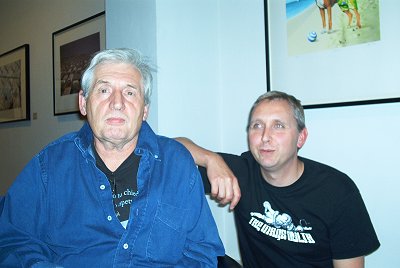
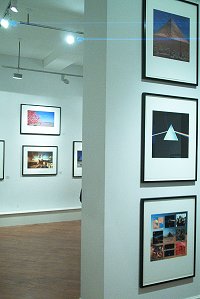 Q:
First of all, obviously, we'd like to know how your health is. There's
an awful lot of concern - has been since the terrible events back in
October [when Storm suffered a stroke on the eve of the Interstellar
exhibition opening]...
Q:
First of all, obviously, we'd like to know how your health is. There's
an awful lot of concern - has been since the terrible events back in
October [when Storm suffered a stroke on the eve of the Interstellar
exhibition opening]... Storm:
Oh yes. The thing really started about three or four years ago, when I
decided to do some prints. I was trying to work out how to make
something more like what it should be. The real problem is that record
covers are mass produced. And they are now small. But the main thing is
that they are mass produced. And anything mass produced doesn't really
have the kind of control that you would like to get if you are trying
to make a good image.
Storm:
Oh yes. The thing really started about three or four years ago, when I
decided to do some prints. I was trying to work out how to make
something more like what it should be. The real problem is that record
covers are mass produced. And they are now small. But the main thing is
that they are mass produced. And anything mass produced doesn't really
have the kind of control that you would like to get if you are trying
to make a good image.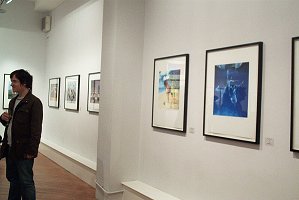 Q: Do you need to have heard the music to come up with the image?
Q: Do you need to have heard the music to come up with the image? 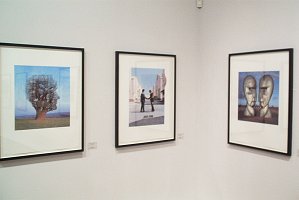 Storm:
Basically, I think Roger hadn't really cracked the writing. It was very
very difficult. Set The Controls is another seminal song for the band,
in my view, because it taught Roger that he could write. But it's very
difficult - you lose your main creative force, your songwriter, your
singer, your frontman, and what do you do? I mean, they didn't chose to
lose him.
Storm:
Basically, I think Roger hadn't really cracked the writing. It was very
very difficult. Set The Controls is another seminal song for the band,
in my view, because it taught Roger that he could write. But it's very
difficult - you lose your main creative force, your songwriter, your
singer, your frontman, and what do you do? I mean, they didn't chose to
lose him.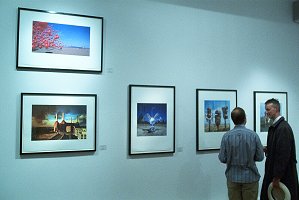 Q: Would you change anything materially? Was there anything you weren't happy with?
Q: Would you change anything materially? Was there anything you weren't happy with? 



